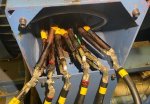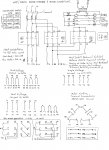emiller233
Senior Member
- Location
- pittsburgh, pa
- Occupation
- Controls-Automation engineer

Either, or can one be both?A 12 lead motor is common for dual voltage, wye-delta starting.
I agree. Very strange that they show a low voltage connection but do not show 230V on the nameplate.To my eye, those 2 wiring choices are both Delta. But one has the pair of coils on each side wired in series (Hi Voltage - the left nameplate diagram) and the other has each pair wired in parallel (Low Voltage - on the right). Your lower "Total Confusion" diagram is the Hi Voltage option, with 3 jumpers (4-7, 6-9 and 5-8) used to connect the windings in series.
I would think the Hi Voltage is 460 and the Low Voltage is 230 - and the nameplate does not properly specify the Low Voltage number (or current). But best to check with the motor manufacture to be sure, I'd not want to guess here with a motor this size. The Low Voltage selection would obviously draw 2x the current, compared to Hi Voltage.
See if this image helps visualize moving each pair of windings next to each other for the Low Voltage choice. When you do that, each corner of the Delta has 4 connections, like the lower right nameplate diagram.
View attachment 2555305
What is your supply voltage to this motor?
To my eye, those 2 wiring choices are both Delta. But one has the pair of coils on each side wired in series (Hi Voltage - the left nameplate diagram) and the other has each pair wired in parallel (Low Voltage - on the right). Your lower "Total Confusion" diagram is the Hi Voltage option, with 3 jumpers (4-7, 6-9 and 5-8) used to connect the windings in series.
I would think the Hi Voltage is 460 and the Low Voltage is 230 - and the nameplate does not properly specify the Low Voltage number (or current). But best to check with the motor manufacture to be sure, I'd not want to guess here with a motor this size. The Low Voltage selection would obviously draw 2x the current, compared to Hi Voltage.
See if this image helps visualize moving each pair of windings next to each other for the Low Voltage choice. When you do that, each corner of the Delta has 4 connections, like the lower right nameplate diagram.
View attachment 2555305
What is your supply voltage to this motor?

Six leads to the starter suggests this was a wye start/delta run set up. Two wires on each connection would suggest running on the lower voltage. I know that the nameplate only shows a single voltage, but a 12 lead motor can always be used on two voltages, with the lower voltage being 1/2 of the higher voltage.yea i should of phrased it better... 'normal' delta wiring vs a pair of delta coils
It is a 480VAC supply. so I'm 'somewhat safe' to assume my 'total confusion' diagram is good for 480?
the data plate doesn't show the low voltage anywhere on it, or are you saying the right side of the data plate is the low voltage selection. i didn't think low voltage was an option since its not slash rated 277/480 (it only states 480)
that definitely helps to visualize the pair of coils. cant say that I've ever seen that before tho...
i put a call/email out to the MFGR and they're not getting back to me... we're running out of time to test :-/
they sent me another picture of it, looks like it had 6 leads coming out of it...?
View attachment 2555308
Either, or can one be both?
Got it.Wye start, delta run at either voltage.
Yesyea i should of phrased it better... 'normal' delta wiring vs a pair of delta coils
It is a 480VAC supply. so I'm 'somewhat safe' to assume my 'total confusion' diagram is good for 480?...
Excellent drawings!!!
So, M1s are always closed, but M2s and Ss are interlocked?


What happens is that (especially with EU suppliers like this), the motor is designed as 690/400V 50Hz, but since 400V 50Hz is the same V/Hz ratio as 480V 60Hz, it is useable at 480V 60Hz, but only in the Delta (Low Voltage) configuration and since 828V is not valid anywhere (the Wye votlage), they don't bother to put it on the nameplate and confuse people.A 12 lead motor is common for dual voltage, wye-delta starting.
The nameplate diagram is what I would normally expect to see expect for the low voltage delta connection. Your diagram depicts the higher voltage delta connection.
While unusual, I think you have to use what’s on the nameplate unless you can get some other verification from the supplier.
so, since I'm not having any luck getting info back from the MFGR, what's the best way to proceed?
assume its a 460/230V 60hz motor and wire it for high voltage (my total confusion diagram)
or
assume its a 690/400V 50Hz motor and wire it for low voltage like the MFGR name plate shows (Jraef explanation as well).
---this seems to be the best option? but if we're wrong it will draw twice the current and blow fuses :-/

That my suggestion as well, power it uncoupled in "high voltage" configuation and see how it responds. Better to supply each coil with too low of voltage for short time than too high of voltageIf it were my decision, I would not hesitate to wire it per the nameplate.
If you’re reluctant to do so, I suppose you could wire it per the conventional high voltage connection and energize (uncoupled from the load, perhaps?) that way. You should be able to quickly observe that the motor is under-powered without damaging it. Just don’t leave it on too long.
FWIW the delta diagram on motor nameplate does not indicate any connections whatsoever, not even where to land supply conductors.I've never seen a motor diagram like the one on this motor. do we jumper the terminals together like they have on their diagram, or wire it to Delta
OPTION A (MFGR)
View attachment 2555299
OPTION B (DELTA)
View attachment 2555300

